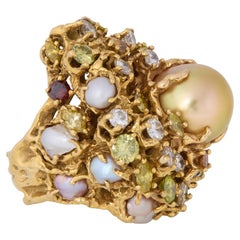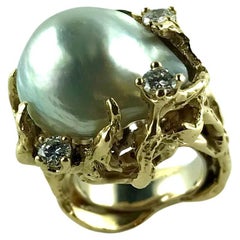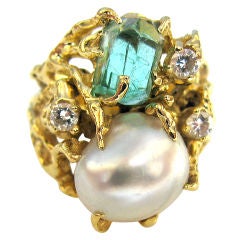King Arthur Pearl Ring
20th Century American Cocktail Rings
Diamond, South Sea Pearl, 18k Gold
Recent Sales
Vintage 1960s American Cocktail Rings
Diamond, South Sea Pearl, Gold, 18k Gold, Yellow Gold
American Cluster Rings
Emerald
American Cocktail Rings
Cultured Pearl
American Cocktail Rings
American Beaded Bracelets
Vintage 1970s American Modern Cocktail Rings
Diamond, South Sea Pearl, 18k Gold, Yellow Gold
Antique 19th Century More Rings
18k Gold, Yellow Gold
20th Century American More Rings
Diamond, Cultured Pearl, 18k Gold
American More Rings
20th Century British More Rings
Diamond, Pearl, 18k Gold
Vintage 1960s American Modern Cocktail Rings
Diamond, Natural Pearl, Yellow Diamond, 18k Gold
People Also Browsed
Early 2000s French Evening Gowns
Vintage 1980s Pendant Necklaces
White Diamond, Emerald, Ruby, Sapphire, 18k Gold, White Gold, Platinum
Early 2000s Italian Top Handle Bags
Early 2000s Italian Evening Bags and Minaudières
Early 2000s Italian Structured Shoulder Bags
1990s French Coats and Outerwear
21st Century and Contemporary Thai Baroque Drop Necklaces
Jade, Pearl, Ruby, 18k Gold, Gold Plate, Silver
21st Century and Contemporary Evening Gowns
Early 2000s French Evening Dresses and Gowns
Early 20th Century French Art Deco Enamel Frames and Objects
Gold Plate, Silver, Sterling Silver, Enamel
21st Century and Contemporary Italian Artist Cocktail Rings
White Diamond, Diamond, 18k Gold, White Gold, Gold
Antique Late 19th Century Unknown Victorian Cocktail Rings
Diamond, White Diamond, Opal, Gold, 18k Gold, Yellow Gold, Enamel
1990s Italian Clutches
Vintage 1970s Link Bracelets
18k Gold
21st Century and Contemporary Shoulder Bags
1990s French Top Handle Bags
King Arthur Pearl Ring For Sale on 1stDibs
How Much is a King Arthur Pearl Ring?
Arthur King for sale on 1stDibs
Self-taught American jeweler Arthur King worked with baroque pearls, geodes, and raw semi-precious gemstones to create distinctive modernist jewelry during the mid-20th century.
Like many of the accessories that populate our jewelry boxes, the forms of King’s provocative vintage brooches, necklaces, rings and other jewels were inspired by the natural world, but the pieces’ metalwork is sculptural and shapely, resembling gnarled tree branches or the surface of an elm’s aging trunk.
King was born in New Jersey in 1921. He became interested in art at a young age and was fascinated with the lost-wax casting technique practiced by some sculptors. King taught himself the process using scrap metals, and his jewelry and objets d’art would come to share common ground with abstract art in the years to come.
While stationed overseas in the Merchant Marines in World War II, King began to work with metal and dabble in jewelry making, integrating sharks’ teeth, white scrap metal and whatever else he could find into his modest “art jewelry,” a term that has been used to describe adornments created by Alexander Calder, pioneering African American studio jeweler Art Smith, Andrew Grima and others over the years. Upon returning from the war, King continued to develop his skills — eventually opening his first shop in New York City's Greenwich Village neighborhood.
King truly distinguished himself from other jewelers of the time — at his workbench, he shaped the brass and silver settings for his often unpolished, chunky stones that featured asymmetrical cuts and employed the age-old technique of lost-wax casting, which sees objects cast from wax models. His early pieces mainly featured silver settings, but his popularity soared once he began to craft jewelry in gold.
In 1961, King's work was exhibited at Goldsmiths’ Hall in London as part of the “International Exhibition of Modern Jewellery” and a year later, he opened his flagship store on Madison Avenue. His success allowed him to open more locations in London, Cape Cod, Havana, Miami and elsewhere.
King used a dizzying array of gems and other materials in his unconventional pieces. And as much as the jewelry of the 1960s featured eye-catching candy-colored stones, it was also an era of new textures and freeform gold settings, and King was at the forefront, creating audacious designs that contrasted sharply with the work of the world’s leading luxury houses.
King’s work has been celebrated at a range of institutions over the years including the Museum of Contemporary Crafts (now the Museum of Arts and Design), the Cultured Pearl Association of Japan, the Victoria and Albert Museum and more. His jewelry was exhibited at the Cincinnati Art Museum’s “Simply Brilliant: Artist-Jewelers of the 1960s and 1970s,” which opened in 2021.
On 1stDibs, find vintage Arthur King brooches, rings, necklaces and more.
Finding the Right Rings for You
Antique and vintage rings have long held a special place in the hearts of fine jewelry lovers all over the world.
No matter their origin or specific characteristics, rings are timeless, versatile accessories. They’ve carried deep meaning since at least the Middle Ages, when diamond rings symbolized strength and other kinds of rings were worn to signify romantic feelings or to denote an affiliation with a religious order. Rings have also forever been emblematic of eternity.
Over time, rings have frequently taken the form of serpents, which have long been associated with eternal life, health and renewal. Italian luxury jewelry house Bulgari has become famous for its widely loved Serpenti motif, for example, and its Serpenti ring, like the other accessories in the collection, began as an homage to jewelry of the Roman and Hellenistic eras. The serpent is now a popular motif in fine jewelry. Jewelry devotees have long pined for rings adorned with reptiles, thanks to antique Victorian rings — well, specifically, Queen Victoria’s illustrious engagement ring, which took the form of a gold snake set with rubies, diamonds and an emerald (her birthstone). Designs for Victorian-era engagement rings often featured repoussé work and chasing, in which patterns are hammered into the metal.
Engagement rings, which are reliably intimidating to shop for, are still widely recognized as symbols of love and commitment. On 1stDibs, a range of buying guides can be found for those in the market for antique engagement rings, vintage engagement rings or Art Deco engagement rings.
The most collectible antique engagement rings and vintage engagement rings are those from the Victorian, Edwardian and Art Deco eras. Named for the monarchies of the four King Georges, who in succession ruled England starting in 1714 (plus King William’s reign), antique Georgian rings, be they engagement rings or otherwise, are also coveted by collectors. Pearls, along with colored gemstones like garnets, rubies and sapphires, were widely used in Georgian jewelry. The late-1700s paste jewelry was a predecessor to what we now call fashion or costume jewelry.
The Art Nouveau movement (1880–1910) brought with it rings inspired by the natural world. Antique Art Nouveau rings might feature depictions of winged insects and fauna as well as women, who were simultaneously eroticized and romanticized, frequently with long flowing hair. Art Deco jewelry, on the other hand, which originated during the 1920s and ’30s, is by and large “white jewelry.” White metals, primarily platinum, were favored over yellow gold in the design of antique Art Deco rings and other accessories as well as geometric motifs, with women drawn to the era’s dazzling cocktail rings in particular.
Whether you’re hunting down a chunky classic for a Prohibition-themed cocktail party or seeking a clean contemporary design to complement your casual ensemble, find an exquisite collection of antique, new and vintage rings on 1stDibs.


